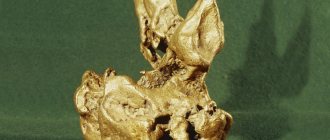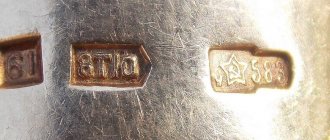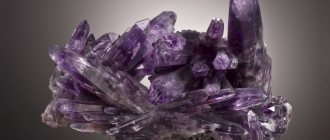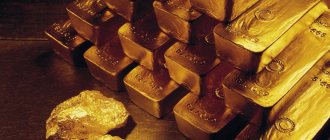Greetings! People have been trying to figure out the origin of gold since ancient times. First of all, those who wanted to quickly get rich were zealous, having learned, with the help of this knowledge, to extract precious metal from stones and garbage. Of course, they didn't succeed.
Scientists have achieved greater success - people driven by a passion for knowledge, and not by greed. Until now, no one has been able to turn stones and debris into gold under terrestrial conditions, but thanks to science we can imagine where it came from on our planet.
Where did gold come from on Earth?
There are many versions - plausible, already refuted and completely fantastic. I will focus on the three most popular.
Hypothesis 1
Once upon a time, people thought that noble metals were formed in the depths of the planet and were brought to its surface due to volcanic processes. This assumption was not confirmed: it was proven that natural conditions on Earth were never suitable for thermonuclear fusion of heavy elements.
Hypothesis 2
According to some scientists, gold is a waste product of certain types of anaerobic bacteria. The influence of the microcosm on the migration of gold and the formation of natural ingots is indeed noted, but the biogenic hypothesis poorly explains the appearance of a new chemical element.
Hypothesis 3
Traditional science believes that the atomic composition of our universe was formed as a result of nucleosynthesis, divided into 3 stages:
- cosmological (primary, prestellar);
- stellar (synthesis of nuclei in the bowels of stars during combustion and explosions);
- synthesis under the influence of cosmic rays.
Before the formation of stars, the Universe consisted of elementary particles and radiation, was small and very dense. After the Big Bang it began to cool and expand. This was accompanied by primary nucleosynthesis, which resulted in the formation of light elements - helium and lithium.
2 billion years later stars appeared. Thermonuclear reactions began to occur in them, making it possible for elements heavier than lithium to appear. This is how silicon, vanadium, and aluminum arose; but pressure and temperature were still not enough to form nuclei with an atomic mass of more than 55.845 units (the mass of iron). Nuclear fusion of heavy elements can only be explosive.
The most viable hypothesis explains the origin of gold through gamma-ray bursts - powerful bursts of electromagnetic radiation in space. They accompany the death of stars - supernova explosions and mergers of neutron stars, as a result of which the emergence of elements with an atomic mass greater than that of iron is possible.
Metallogenic eras
Before considering aurogenic epochs, let's look at the epochs of general metallogenesis (age is given in million years):
- Vendian
(570-610) [close zircon peaks: 142, 300, 370, 425, 642]. Then a pause of about 400 million years [until the end of the Mesozoic and the beginning of the Cenozoic?]. - Middle Riphean
(1000-1350) [zircon peaks: 920, 1100, 1250]. - Early Riphean
(1350-1650) [zircon peaks: 1550]. - Svecofennian
(1650-2100): Svecofennian (
Vepsian
: 1650-1800) [zircon peaks: 1750]. - Svecofennian ( Calevian
: 1800-1920) [zircon peaks: 1950]. - Svecofennian ( Ludicovian
: 1920-2100) [zircon peaks: 2130].
(2400-2500). Before this there is a pause of 300 million years.
(2500-2800) [zircon peaks: 2650 (middle), 2730].
(2800-3000) [zircon peaks: 2900 (middle)].
At Voitekhovskaya
a number of gold mining epochs are noted, among which
the Late Archean
(2.9-2.6 billion years ago) [Late Lopian era], represented by deposits of
the Witwatersrand
(South Africa),
Kalgoorlie
(Western Australia),
Hemlo
,
Yellowknife
, and characterized by the widespread development of active volcanic and post-volcanic processes, stands out .
This is followed by maxima of 1.7-1.6 [end of Svecofennian], 0.8, 0.4-0.24 and 0.2-0.01 billion years ago. The Paleozoic
and
Meso-Cenozoic
maximums mean a new activation of the gold mining process. Moreover, the periodicity of gold mineralization maxima approaches the periodicity of orogenic endings in the tectonic history of the Earth.
In what form can gold be found in nature?
Gold, like almost the entire periodic table, came to Earth from space as a result of meteorite bombardment. This happened when our planet was not yet solid. In the process of its formation, a liquid melt of substances (one of the main metals in it was iron) sank inside the globe, and this is how the earth’s core was formed.
Most likely, it mostly consists of heavy precious metals that sank to the center of the Earth along with iron.
Unfortunately, precious metals cannot be extracted from there, and one has to be content with only crumbs of wealth hidden in more accessible depths.
Nuggets
Native gold is the dream of every prospector. The leader in the number and size of nuggets found throughout history is Australia. How are they formed?
There is a “V-theory” that explains the specific occurrence of nuggets by the fact that we are observing only the remains of gold deposits. When igneous rock first solidified on the earth's crust, the largest veins and purest gold were located at the top of the ore system. Since then, eons have passed, and the upper part of the deposit has completely eroded.
This version is confirmed by the fact that most large nuggets are found close to the surface - in veins near the main ore body. These small veins could serve as a filter, passing through a gold-containing solution, which formed nuggets when cooled.
grains
Grain metal is the name given to gold grains collected from a vein. Grains are much easier to find than natural ingots, but they are also a desirable object for prospectors who mine precious metals. The grain is almost pure gold of a rich yellow color, the amount of impurities in it is small.
What is the difference between nuggets and grains
A grain is a natural small ingot. The main differences from a nugget are in size and rarity (it is very difficult to find a large nugget; these are isolated cases that become world famous).
There is no clear opinion regarding the mass from which gold can be considered native. Some gold miners claim that a miniature nugget can weigh as much as 1 g, while others claim that pieces of metal weighing less than 15 g should not be called nuggets.
Interesting facts about Au
There is some information that may seem interesting, it also concerns the noble metal:
- Scientists were able to establish that conditions for the formation or formation of a noble metal have never existed and could not exist on our planet. For this reason, gold is clearly of cosmic origin.
- The metal was most popular in the 14th century in the Inca Empire. The Incas believed that gold was of divine origin and for this reason they presented figurines made of this metal as gifts to the gods. The Empire created a temple, which was decorated from the inside with Au plates. When the Spaniards learned about such riches of the empire, they were shocked not only by the beauty of gold products, but also by the size of its production.
- Today, Au mining is associated with great difficulties. About 80–90% of the cost of the precious metal is the cost of finding a new deposit, its exploration and development. Everything else is the work of the master who makes the products (if we are talking about jewelry).
- The exact amount of gold that has been mined by mankind is unknown. They say that if all the metal were collected and melted into one piece, it would be in the shape of a cube the size of a tennis court. The height of the cube will not exceed two meters.
- Many people know that humanity has suffered from gold rushes more than once, but if we evaluate all production volumes, then most of the metal was mined in the 70s of the 20th century.
- Au, according to investors, is the most stable metal. Investments in gold invariably bring profit and help you get rich. Au is most popular in Asia and India.
- For a long time, it was not possible to discover a single large Au deposit on the territory of Rus'. Metal was purchased abroad, and all the efforts of the rulers were nullified. After several years of searching, only a small nugget was found, from which the king was made into a ring.
For many centuries, Au has been a symbol of wealth and prosperity. The yellow color of the metal has captivated many. Of course, scientists are debating how the element got to our planet and where it actually came from. And humanity continues to enjoy the beauty of this metal, without even thinking about the origin of gold. Let new information appear, theories and legends, myths and hypotheses, gold has always been shrouded in mystery. Maybe for this reason it attracts and fascinates people.
Types of deposits
Deposits are divided into primary - post-magmatic - and secondary, formed as a result of the destruction of the first.
Indigenous
Ore deposits are localized on the surface of the earth's crust in places where molten magma came out (for example, during volcanic eruptions). Until the 20th century, they were poorly developed, because the extraction of gold from rock is labor-intensive and ineffective without technical means. But in the 20th century, humanity took revenge and in a hundred years produced the same amount of gold as thousands of years before.
Alluvial
Placers of gold - concentrate - are found mainly in alluvium ("alluvium" - deposits formed by water flows). It is interesting that sometimes alluvial deposits are found in places hundreds of kilometers away from the original ones. After washing, spot gold (“rough”) gold is chemically purified.
Geological epochs of gold formation
It turned out that the distribution of deposits in geological time has a pronounced discrete nature. The emergence of the most significant gold deposits is associated with certain stages in the development of the Earth, and they are confined to geological formations of a special type. [Let us consider these aurogenic epochs against the background of general metallogenic ones.]
- 3.8-2.8 billion years ago, ore formation began on Earth. This was the Archean [lower and middle Archean] metallogenic era, covering the era of the proto-continent Vaalbara. Giant gold deposits of the most ancient shields were formed: Porcupine, Kirkland Lake
- on the Canadian Shield;
Kalgoorlie
and others - in Western Australian;
Kolar Goldfields
- in Hindustan;
ore fields of Western and Southern Africa. In all these deposits, gold is contained in thick quartz veins. The deposits of this era are very unique and in many ways unlike younger ones. Thus, the Yellowknife
(translated from English as the Yellow Knife) is represented by a suite of ore veins up to 4 km long, with consistently high metal contents. And the largest, continuously mined vein of the Kirkland Lake deposit was traced for 2 km. But, perhaps, the most characteristic is the stable high vertical gold content, due to which the mining depth of many deposits exceeded 2000 m, and at the unique Witwatersrand deposit in South Africa reached 3.5 km [already 5!]. - 3.2-2.5 billion years ago, the richest deposit on our planet was formed - the Witwatersrand
in South Africa. This orogeny also belongs to the Archean [Upper Archean - more precisely, Mesoarchean-Neoarchean] metallogenic era, coinciding with the era of the Kenorland proto-continent. - 2.5-1.9 billion years ago the Homestake gold deposits in the USA, Sukhoi Log in the Baikal region and the Boliden gold pyrite deposit in Sweden were formed. This geological process occurred in the Early Proterozoic metallogenic era, almost coinciding with the era of the Columbia continent.
- [Nothing is said about aurogenesis in the Middle Proterozoic (1.9-1.65 billion years ago - gold of Sudan), Early Riphean
(1.65-? billion years ago - Yakutia, Sudan) and
Late Riphean
(?-0.57 billion . years ago - massive development of copper sandstone deposits, manifestation of hydrothermal deposits of gold, copper, tin and tungsten) metallogenic eras.] - Almost 1.5 billion years [2 Willis cycles = 8 galactic years] lasted a geological pause in the formation of gold [with the exception of the Lower Paleozoic deposits of Southern Siberia - Eastern Kazakhstan], which was replaced by 400-250 million years ago [Upper Paleozoic: Devonian - Permian] bright and a very productive stage ( Caledonian
metallogenic era).
During this period, two powerful mountain belts emerged - East Australian
and
Ural-Mongolian
. Each of them is the richest gold mining province, from whose deposits thousands of tons of gold were extracted. - 250 million years ago [the end of the Paleozoic - Mesozoic] a new cycle of ore formation began ( the Hercynian
metallogenic era): folded belts grew around the Pacific Ocean depression and numerous gold deposits in Chukotka, Kolyma, Primorye and the Amur region. The Caledonian and Hercynian metallogenic epochs (as well as the Alpine epoch that replaced them) lie in the middle of the epoch of the proto-continent Pangea. - [It is also not said about the formation of gold in the next - Alpine
(50 million years ago - Cenozoic [Paleogene]) metallogenic era, when the gold deposits of Kamchatka, the Philippines and the Caribbean were formed.
of the Alps, Caucasus
and
Himalayas
not formed in the “alpine orogeny” ? And wasn’t there plume gold formation in the Cenozoic?]
That is, in the geological history of the Earth there were 2 main episodes in the formation of gold deposits. The first covers the very initial stages of the Earth's development, and the second covers the last few hundred million years.
(Based on the article “Gold is a Mineral”)
Configurations of continents during metal formation epochs
Diagrams of the hemispheres are given from the present era deep into millions of years on the scale of galactic years (according to the concept of the author of the site I.G.).
| Galactic year 24 ( Alpine orogeny): Cenozoic (-66 Ma) |
| The dynamics of the latitudinal separation of the continents around the meridional axis of the Atlantic Ocean, which began in the previous period, was supplemented by the meridional separation of the continents, as a result of which Antarctica “crawled” to the south, and Africa, the Indian subcontinent that separated from it, and Australia that separated from Antarctica began to move north towards Eurasia, crushing it land to the Alpo-Caucasus, Himalayas and Indonesia. This mountain building process is called alpine . Perhaps, at the same time, South America is also moving onto North America, tectonizing the Caribbean. In the Alpine era of aurogenesis (50 megayears ago), gold deposits of Kamchatka , |
| Galactic year 23 ( Cimmerian and Hercynian orogenies): Mesozoic (-251 mil BP) |
| 250 million years ago (end of the Mesozoic) began Hercynian tectonomagmatic (and corresponding metallogenic) era with a new cycle of ore formation: folded belts grew around the Pacific Ocean basin and numerous gold deposits |
| Galactic year 22 ( Caledonian orogeny): Upper Paleozoic [Devonian] (-400 mil BP) |
| In a bright and productive Caledonian During the metallogenic era, two powerful mountain belts emerged - |
| Galactic year 21: Lower Paleozoic [Cambrian] (-570 mil BP) |
| Deposits of Southern Siberia - Eastern Kazakhstan. |
| Galactic Year 20: Lower Neoproterozoic [] |
| Late Riphean metallogenic era (Vendian/Ediacaran at the end of the Neoproterozoic? -0.57 billion years ago) - massive development of deposits of cuprous sandstones, manifestation of hydrothermal deposits of gold, copper, tin and tungsten [where?]. |
| 16th Galactic Year: |
| Early Riphean metallogenesis (Mesoproterozoic 1.65-? billion years ago) in the era of |
| Galactic Year 15: |
| Middle Proterozoic aurogenesis (1.9-1.65 billion years ago) in |
| 12th galactic year: Alconk tectonogenesis (2500-2230 million years ago) in the Siderian period (2.5-2.3 billion years ago) of the beginning of the Paleoproterozoic. |
| 5-9 galactic years: the Archean metallogenic “epoch” [in fact there were several epochs, of course] localized on the first 2 cratons [the beginnings of the continents] of the Earth - Kaapvala and Pilbara , for some time united into the first monocontinent Vaalbara [3,8 — 2.8 billion years ago?]. |
| In the middle of this Archean eon (in the late Paleoarchean), the oldest known tectonomagmatic era is discovered - Belozerskaya 3500–3050 million years ago [7th galactic year]. |
Gold among ancient peoples
The history of this precious metal begins in ancient times. However, there is no archaeological evidence for the exact time when its use began. Scientists can only guess about this period.
Gold was probably found at different times and in different places. Thus, pieces of precious metal were discovered in Spanish caves, where people lived about 40,000 years ago.
But we can only say for sure that gold was most widely used in Egypt, India and China. Apparently, ancient civilizations mined it from various deposits in the Middle East. Many researchers believe that the Egyptians were the first. The lands of the Upper Nile and the Nubia desert brought them most of their resources.
Pharaohs and sacred ministers used this metal as temple decorations. This is approximately 3000 BC. e.
However, it is interesting to note that for a long time the medium of exchange of Egypt was not gold, but barley. The first use of gold as money was in 700 BC. e. in Lydia (modern Türkiye). And only then did the Egyptians switch to a similar system.
According to the most popular version, the largest gold reserves were concentrated in Egypt. However, they were subsequently taken out of there during wars. Finding itself first in Assyria, the gold passed to Babylon, and then to the Persian Empire and Rome. And after the fall of the Roman Empire it spread to different countries.
Gold came to Mesopotamia and Palestine from Egypt and Arabia during the development of trade. The oldest gold finds in this area date back to 961-922 BC. e. This is the reign of King Solomon.
The gold that lay in the treasuries of the Aztecs and Incas of Mexico and Peru is believed by researchers to have come there from Colombia. True, the conquistadors plundered these treasuries, and many precious artifacts were melted into coins and bars.
This is the only metal that has caused a huge number of wars. Among the famous golden battles are: the conquest of Babylon by Persia, the battle of Alexander the Great, as well as Caesar’s wars with Gaul and Egypt.
Exchanges
Gold can bring a lot of money at the moment. Many people make fortunes from the difference from buying and selling precious metals. In the modern world, this can be done without even holding it in your hands. Online exchanges give any broker the opportunity to buy and sell this metal remotely. Using long-term charts, you can study what the history of the gold price was at one time or another. And we will see that in the long term, investing in gold has always been profitable. Read more about investing in gold in this section.
The gold standard: a brief historical excursion
The gold standard is an accepted system according to which the value of money is equivalent to a certain amount of gold. Initially, the silver standard was adopted. But later the silver was replaced.
This approach had many advantages:
- durability of the metal and its immutability;
- good divisibility;
- high level of cost;
- characteristic differences from other metals.
One of the principles of the gold standard is that any money can be quickly exchanged for gold. This is a guarantee of no inflation.
This model first appeared in England at the beginning of the 19th century. And the pound had the status of a currency recognized throughout the world for a long time - until 1914. During the Bretton Woods Conference, this standard was legalized.
At the end of the 20th century, America abandoned this system. And after some time, the standard ceased to be used at all. This happened for several reasons:
- Difficulty moving large amounts of money.
- Difficulty in issuing.
- Possibility of resource loss.
Since the present time is characterized by many financial crises, economists have proposed returning to the standard. However, gold reserves are too small for this. And they are unable to ensure full monetary circulation.
In industry
The special properties of the metal have given it special significance in industry. It is used:
- in the transport industry;
- in energy;
- in the chemical industry;
- in telecommunications;
- in nanotechnology;
- aviation;
- in the space industry.
For medicinal purposes, gold is also of great importance. It is used for dental work, for rejuvenation and for the treatment of certain diseases, such as:
- colds;
- heart disease;
- diseases of the nervous system;
- development of atherosclerosis.
How to find a place to mine gold?
Rivers with golden sand often have black sand mixed in. So black, reddish, or even orange soil is a sign of gold
.
Metal detectors on such soils usually “go crazy”, producing a sea of erratic signals, so it is better to use special ones created specifically for searching for gold
.
Interesting materials:
When is the draw for the 2022 2020 Champions League? When will the results of the Victory dictation 2022 be known? When will the results of admission to the university be known? When will the topics of the final essay be known? When will there be new emoticons? When will the decorations be removed in Moscow? When will they build a bridge across the Volga in Tolyatti? When is Twilight 2022? When is Spring Break? When will GTO badges be awarded?
Jewelry industry
Gold jewelry has been made for more than 5 thousand years. The history of gold and gold jewelry walk together all the time.
Jewelry still has a certain value. Over time, manufacturing methods have changed and jewelry made from that metal has changed slightly.
Modern jewelry has become more aesthetically pleasing, but it also represents wealth and a certain status. The range of jewelry today is very large, almost anyone can choose the thing that they like. Only now jewelers no longer make them from the purest material; modern gold jewelry consists of alloys.
Gold reserves of countries around the world
The gold reserve is the stock of gold, which is in the power of the Central Bank of a certain country and is a certain part of the gold and foreign exchange reserve. To date, the amount of gold mined is 174,100 tons. According to the World Gold Council, the volume of gold reserves by country is 30,000 tons. In the table below you can compare gold reserves of different countries of the world (relevance as of June 2014):
| # | a country | gold reserves, tons |
| 1 | USA | 8 133,5 |
| 2 | Germany | 3 384,2 |
| 3 | International Monetary Fund (IMF) | 2 814 |
| 4 | Italy | 2 451,8 |
| 5 | France | 2 435,4 |
| 6 | Russia | 1 112,5 |
| 7 | China | 1 054,1 |
| 8 | Switzerland | 1 040 |
| 9 | Japan | 765,2 |
| 10 | Netherlands | 612,5 |
| 11 | India | 557,7 |
| 12 | Türkiye | 512,9 |
| 13 | European Central Bank (ECB) | 501,4 |
| 14 | Taiwan | 423,6 |
| 15 | Portugal | 382,5 |
| 16 | Venezuela | 367,6 |
| 17 | Saudi Arabia | 322,9 |
| 18 | Great Britain | 310,3 |
| 19 | Lebanon | 286,8 |
| 20 | Spain | 281,6 |
| 21 | Austria | 280 |
| 22 | Belgium | 227,4 |
| 23 | Philippines | 194,3 |
| 24 | Algeria | 173,6 |
| 25 | Kazakhstan | 155,8 |
| 26 | Thailand | 152,4 |
| 27 | Singapore | 127,4 |
| 28 | Sweden | 125,7 |
| 29 | South Africa | 125,1 |
| 30 | Mexico | 123,3 |
The USA takes first place. It was gold bars in this country that became a substitute for the dollar, after its role as a reserve currency decreased. Thus, gold sales in the United States may help reduce pressure from buyers of precious metals.
Germany is in second place. In the period 2003-2008. It was this country that occupied a leading position in the sale of gold. But these sales did not in any way reduce the country’s own gold and foreign exchange reserves. Therefore, Germany will continue to sell this metal without harming the economy.
Italy is in fourth place. Since this country now has large debts, it can be assumed that in the near future it will begin to actively sell its gold reserves.
After Italy, France continues the ranking of countries. This country will sell gold steadily, as the reserves allow it.
In sixth place is Russia. Over the past six years, Russia has doubled its gold reserves - from 520 tons in 2009 to 1,100 tons by mid-2014. Active replenishment of reserves began immediately after the 2008 crisis. Apparently, the Russian government does not rule out repeated crises in subsequent years and is stocking up on a liquid asset that has value under any circumstances.
Next comes China. The population of this country is large and the economy is developing rapidly. Between 2003 and 2009 China purchased about 450 tons of gold and about 200 tons in 2010. The country is actively converting its reserves into gold.
Switzerland is actively opposing the increase in the exchange rate of the Swiss franc. Therefore, the country is selling gold; there is no point in increasing reserves.
Japan took the next place in the ranking. After a long period of economic stagnation, Japan began to sell off its gold reserves. The reason for this was the surplus of these reserves and the stability of the national currency.











